A complete guide about the cause of stress and different activities that you can do…
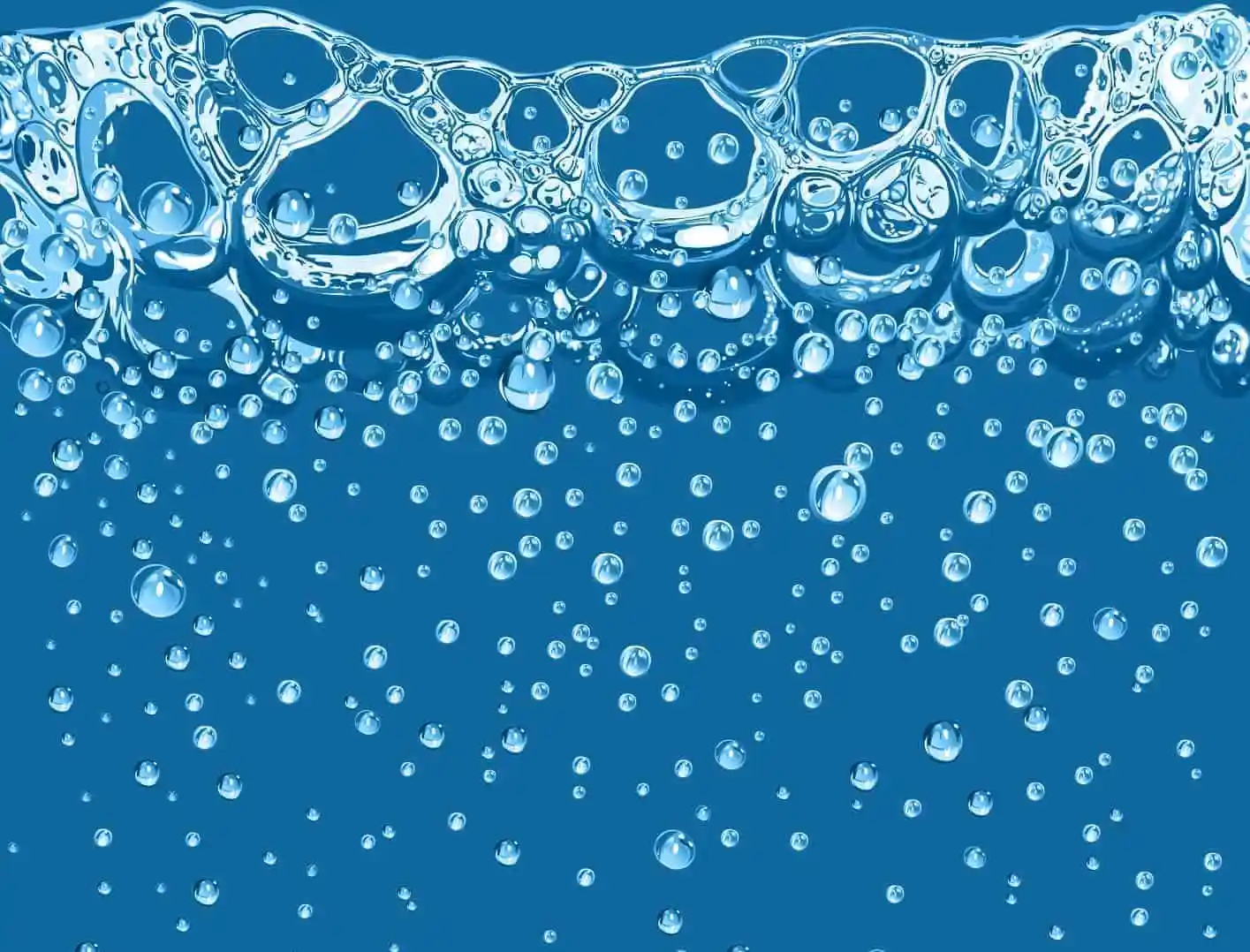
30 Key Hot Tub Facts, Trends, and Questions
If you’re looking for a hot tub or industry facts, statistics and questions, we’ve got you covered. We’ve compiled the most comprehensive hot tub market data all in one place.
If you’re looking for a hot tub, then we want to show you some of the most relevant facts and stats about hot tubs. You’ll learn some of the hot tub benefits, hot tub safety facts, and the key numbers you need for hot tub ownership.
We’ll begin by looking at some key hot tub info to help you understand their benefits, history, and market trends.

Hot Tub Health Facts
We’ve compiled a few of the most relevant health benefits for you, showcasing why facts about spas highlight their wellness advantages.
- A Hot Spring customer survey revealed a few of the most common health reasons people put on a bathing suit and jump in. Source: prnewswire.com
- 33.3% of hot tub owners use their hot tub at night to help with their trouble sleeping. The rise in body temperature followed by the drop in temperature when they get out helps to bring on sleep.
- 49% of owners use the warm water to improve their recovery from exercise. After a gym session or a tough workout, owners jump in the tub to ease muscle soreness.
- 20% of owners use their hot tub to boost recovery from injury. Hydrotherapy provides water pressure delivery exactly where it’s needed to provide pain relief.
- The hot tub water temperature shouldn’t be higher than 104 degrees Fahrenheit, and the United States CPSC recommends keeping it at 100 degrees.
Source: hotspring.com - An analysis of multiple studies of people using balneotherapy (bathing in natural hot springs) and mud/peloid therapy shows a significant impact on cortisol levels. Cortisol is the stress hormone. Lowering cortisol can lead to improved sleep, lower blood pressure, and even weight loss.
Source: pubmed.ncbi.nlm.nih.gov - Using hot tubs can result in lesser symptoms of rheumatoid arthritis. While the long term studies still need to be done, the indications show there is some evidence that hydrotherapy is better for people with RA in the short term than nothing or other treatments in terms of reducing pain and improving their health.
Source: pubmed.ncbi.nlm.nih.gov
These health benefits, and more, are part of the driving force in the consumer hot tub market. More and more people are turning to in-home health alternatives, making hot tubs a popular choice for wellness.
Hot Tub Information – Most Common Hot Tub Questions Answered
Hot tub information is key for potential owners, so we’ve answered some of the most common questions to help you decide if a hot tub is right for you.
Staying in a hot tub for too long might cause you to overheat, which can lead to fainting, dizziness, and even nausea since the water temperature is greater than your body temperature. The onset of these signs and symptoms is your body’s way of urging you to exit the hot tub and return to a more comfortable temperature.
Using a hot tub can reduce the levels of cortisol in your body, which in turns lowers stress and promotes better sleep. As long as you monitor your body’s temperature and do not become overheated, there are no problems with using a hot tub every day.
Using a hot tub can produce these benefits:
Eliminating Sources of Stress
Unwinding muscle tension
Restful sleep
Reduced chronic pain
Enhanced insulin sensitivity
Improved heart health
Slight boost in metabolism
The hot tub may also be used as a restorative tool to help you relax your muscles and get a better night’s sleep after your workout. After strenuous exercise, a soak in the hot tub for 10-25 minutes may do wonders for relieving muscle tension and stress.
Certain individuals, such as pregnant women and those with heart problems, should take care with hot tubs. However, even perfectly healthy individuals might become sick from improperly cleaned equipment. So, provided your hot tub is clean and you monitor your body temperature, they should be safe.
Pregnant women should use hot tubs with caution, if at all. Never heat the water in the hot tub to more than 104 degrees Fahrenheit (40 degrees Celsius). You and your growing child are at risk if your body temperature rises due to sitting in hot water.
You may lose weight in a roundabout method, but soaking in your hot tub every day might help you get there faster. Submerging yourself in a hot tub for 15 to 20 minutes will help you burn up to 17 calories, or. 005 pounds of fat, if you weigh approximately 150 pounds.
The engineers at Wellis Spa set out to create the strongest jets that massage the largest portion of the body. The Infinity Jet they created on their LifeLine provides a massage experience unlike any other as it provides it’s powerful massage in an infinite figure eight as it turns.
Manufacturers nowadays often market their hot tubs’ operating costs at between a dollar per day and fifty dollars per month. The heater in a hot tub is the primary factor in the hot tub’s energy consumption, and its power consumption may range from 1,500 watts to 6,000 watts. The pump consumes an additional 1,500 watts of power.
With the aid of the hot water, the massage jets, and the buoyancy effect, lactic acid is flushed out of the muscles and the body is relieved of discomfort. Just 15 minutes in a hot tub about an hour and a half before bedtime may alleviate the discomfort that prevents you from getting comfortable and sleeping well.
The most energy-efficient hot tubs come from the Wellis LifeLine series and include the Malaga Hot Tub, which is available to the US market now. The advanced insulation and energy efficient tech allows the tub to conserve energy, using as little as 3.4kW per day. That’s less than a lightbulb.
Five to twenty years is a reasonable estimate for how long a hot tub will last. Low-cost hot tubs often aren’t very well constructed and don’t survive very long. These hot tubs may not survive more than 5 years if they are not properly cared for. If you take good care of your hot tub, you may use it for 20 years or more.
Fascinating Hot Tub Facts
Hot tubs have a rich history and some surprising quirks that make them even more interesting. Here are some facts about hot tubs that might surprise you and show why they remain so popular today.
- Hot tubs date back over 4,000 years to Ancient Egypt, where hydrotherapy was used for relaxation and healing. The practice also appeared in Japan around 552 AD, with hot springs believed to purify the body and bring good luck. Source: Leisure Works, Hydropool Surrey
- The modern hot tub owes its name to the Jacuzzi brothers, who in 1925 adapted an aviation pump for hydrotherapy, creating the iconic Jacuzzi brand. Source: Jacuzzi
- In Japan’s Nagano Prefecture, monkeys visit natural hot springs in winter to stay warm, showing that even animals enjoy a good soak! Source: Hydropool Surrey
- Over 43,000 champagne bottles are popped in hot tubs each year, making them a go-to spot for celebrations and social gatherings. Source: Texas Hot Tub Company
These tidbits highlight the cultural and historical appeal of hot tubs, proving they’re more than just a backyard luxury—they’re a timeless way to relax and connect.
Hot Tub Ownership Stats
Are hot tubs still popular? The answer is a resounding yes, and these hot tub stats reveal just how widespread their use is, along with practical insights for owners.
- There are approximately 7.3 million hot tubs in the U.S. and 26 million worldwide, with over 17,000 people soaking in them at any given moment. Source: ConsumerAffairs
- Hot tub owners keep their tubs for an average of 7.5 years, and nearly 40% of hot tubs are sold secondhand or given away, showing their lasting value. Source: ConsumerAffairs
- The longest recorded hot tub session lasted an impressive 306 hours, though experts recommend limiting sessions to 30 minutes for safety. Source: FROG Products
These numbers show that hot tubs are a staple for many households, offering both relaxation and resale potential for savvy owners.
Hot Tub Market: Competitive Insights
The market for hot tubs is very competitive. Many players are getting more customers by putting out new products and adding features that use less energy. This can be done by doing a lot of research and development work.
Research and development work is what helps the superstars in the hot tub industry make more money in new ways.
Also, strategic partnerships are a very important part of the expansion of the global market. Consolidations, buyouts, joint ventures, and alliances help the businesses in the hot tub market improve their position, which increases the growth rate.
Wellis Spa, Jacuzzi, Artesian Spa, Bullfrog International, and Blue Falls Manufacturing are all well-known names in the hot tub market.
The number of people who want hot tubs has grown a lot over the years. Producers in the hot tub industry are concentrating on producing hot tubs with more than one use, like solar hot tubs and wood-fired hot tubs. People like these hot tubs because they are easier to use and better for their health. So, these things could help the market for hot tubs grow.
Hot Tub Industry Statistics
The pandemic was a huge year for hot tub sales. People were forced to cancel their vacation plans, stay home, and stay away from gyms, spas, and wellness centers. So, they bought hot tubs. And they are continuing to buy more hot tubs.
- The hot tub market is projected to register a CAGR of 9.63% over the forecast period, 2021-2026. As people rebound from the pandemic, strong growth is expected. These promising hot tub statistics should be good news to anyone in the industry.
Source: mordorintelligence.com - Based on these figures, about 4.6% of US households and 1.8% of people have a hot tub at home. This figure may actually be a little too low and certainly only accounts for single-family homes. Many more people access a hot tub location such as a gym, apartment complex, or health center.
Source: powerpersquarefoot.com - The hot tub market is expanding globally. Roughly 38% of future growth is expected to come from Europe. A few variables affect purchase rates, such as disposable income, property prices, and the cost of hot tub water care.
Source: technavio.com - There are an estimated 5.8 million hot tubs in the USA. Hot tub owners come in all ages and areas.
Source: Townleypoolandspa.com - 73% of people buy hot tubs to enjoy hydrotherapy or help with a physical condition. A hot tub heats joints and many people find this eases the symptoms of arthritis and aids in recovery and rehabilitation.
Source: aquamagazine.com - A recent Power Per Square Foot (formerly H2Insider) survey of 500 people in the US age 18 and older found 8.1% of respondents currently own a spa, with just over 18% having owned a spa at some point.
Source: powerpersquarefoot.com - When people were asked to rank these in the order which they would be most likely purchase them, a hot tub was either #1 or #2 for over 27% of people. This means that an energy efficient hot tub is a durable luxury good. They will continue to sell well as the economy goes up and down.
Source: powerpersquarefoot.com - While the hot tub market is growing, the Hot Tub Manufacturing sector is shrinking in the USA. The manufacturing industry shrank by 0.6% per year during 2017-2022. This could be due to lower hot tub prices, supply chain issues, and more hot tubs produced overseas.
Source: ibisworld.com - According to the data released by the American Med Spa Association, in 2018, the average medical spa revenue generated in the United States is evaluated to be USD 1,526,382. People come to medical spas for warm water, relaxation, and care for their ailments.
Source: fortunebusinessinsights.com - Hot tubs can improve other businesses, especially hotels and private accommodation. Airbnb estimates adding a hot tub increases booking rates by 13% and the average nightly cost by $39. One hot tub can turn a marginal property into a far more popular and lucrative business.
Source: aqualivingstores.com
The hot tub industry is doing well and recording year on year growth. While there are challenges to the manufacturing side of the industry, the consumer demand is strong.
To give you a quick snapshot, here’s a table summarizing key hot tub market statistics for 2023 and beyond.
| Metric | Value | Source |
|---|---|---|
| Global Market Size 2023 | $4.3 billion to $5.48 billion | Global Market Insights, ConsumerAffairs |
| Projected Market Size 2029 | $6.68 billion | ConsumerAffairs |
| U.S. Hot Tubs | 7.3 million | ConsumerAffairs |
| Global Hot Tubs | 26 million | FROG Products |
These figures highlight the robust demand driving the hot tub market, making it a great time to consider ownership.
US Google Trends for Hot Tubs
During the past five years, Google Trends shows a spike in interest during 2020.
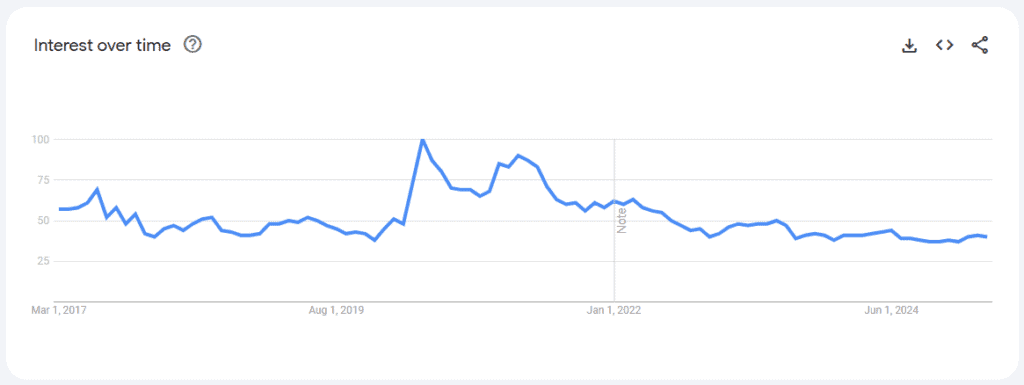
The pandemic hot tub spike is easy to understand. People had to find more ways to enjoy being at home, so hot tubs were a natural thought. However, the continuing interest in them is a good sign for hot tub sellers.
People have followed the same trend when searching for “inflatable hot tub.” Here is the Google Trend graph for this term during the past five years:
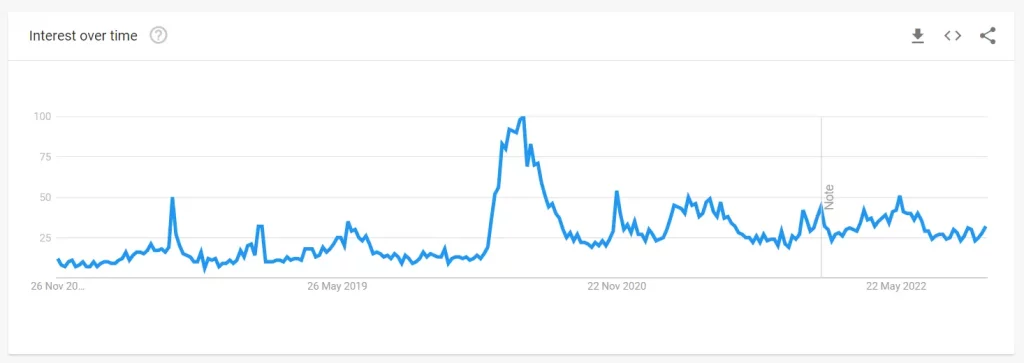
Hot tub accessories are popular and some are necessary. A hot tub cover, for example, is very important and helps to significantly reduce monthly costs. Weather and climate have a drastic impact on hot tub temperature.
Google Trends shows how smart consumers farther north look for a cover for their hot tub:
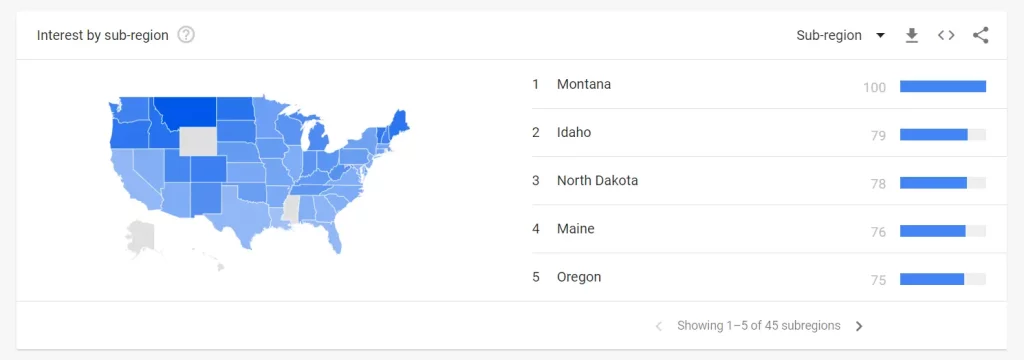
Likewise, the interest in “hot tub chemicals” has also been increasing. This makes sense because more people own hot tubs and so more people are looking for hot tub chemicals to keep their tubs clean. Bottled chemicals are the most common form of product. Here is a Google Trends graph showing the interest in hot tub chemicals over the last five years:
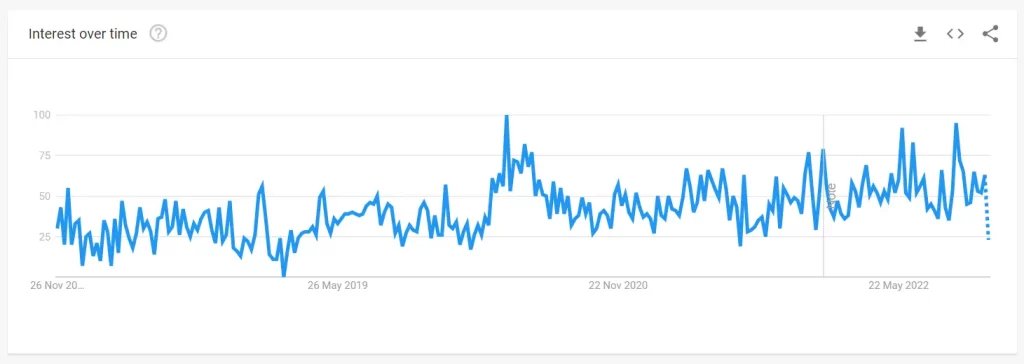
These positive trends have a few things in common:
- All of them experienced a spike during the Covid-19 pandemic.
- They reflect consumer interest in more ways to enjoy being at home.
One of the meta trends that is influencing the market is the shift to doing more therapy at home. This Google Trends graph shows the spikes and interest increasing over time for the term “in home physical therapy:”
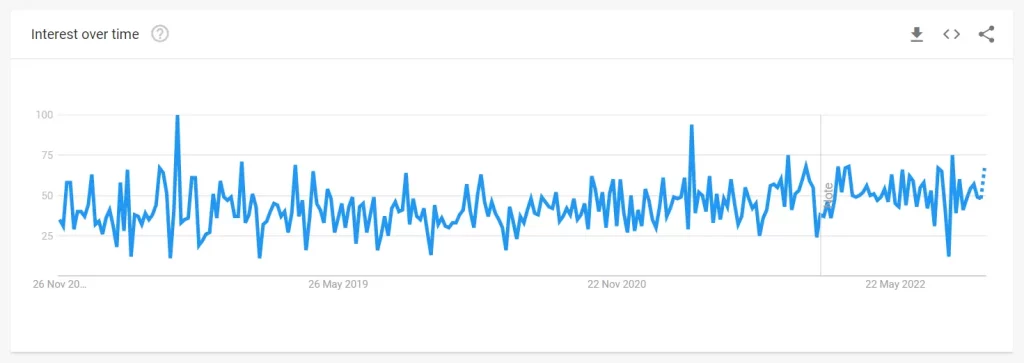
How to Choose a Hot Tub
Many people don’t know how to choose a hot tub. There are just too many choices! To help you, here’s a little process you can go through:
- First, evaluate your space and decide on the size of hot tub you can fit. Larger hot tubs are tempting, but you don’t want to feel crowded or like the hot tub doesn’t fit.
- Second, think about the hot tub specifications you want. Your hot tub’s specifications will affect both your budget and how much you enjoy it. For example, top tier saltwater systems are very clean and hygienic, but cost slightly more. Make a list of the things that are most important for you.
- Plan your installation. You’ll need to think about a garden hose, pump power source, and a few other details. A good dealer can help you with this.
- With those three steps completed, you should have a good idea of the size and specifications of the hot tub you can buy. Now, it’s time to get to a dealer or a good website and pick out your favorite.
If you have any questions, contact your local dealer. The team at Epic Hot Tubs will be really pleased to help you choose the perfect hot tub for your home.

Interested in a Hot Tub in North Carolina?
We have two showrooms in NC, including one in Raleigh and one in Durham. Call 888-884-3742 or Fill Out the Form Below to Contact Us Today
Richard Horvath
Richard has been in the hot tub & spa industry for years. As a long hot tub & swim spa owner himself, Richard has a passion for helping homeowners create their dream backyard.



